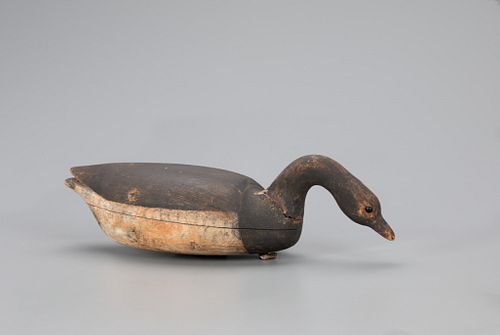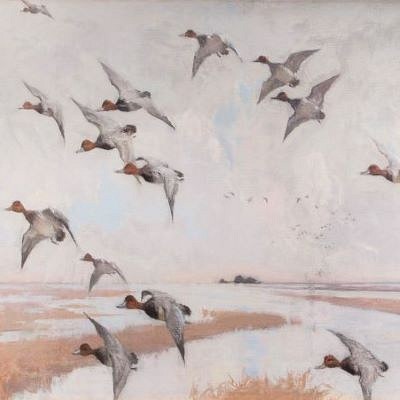The Mackey Cobb Feeding Brant Decoy, Nathan F. Cobb Jr. (1825-1905)
About Seller
20 Winter Street
Pembroke, MA 02359
United States
Founded in 2005, Copley Fine Art Auctions is a boutique auction house specializing in antique decoys and American, sporting, and wildlife paintings. Over the course of the last two decades, the firm has set auction records for not only individual decoy makers, but also entire carving regions. Copley...Read more
Two ways to bid:
- Leave a max absentee bid and the platform will bid on your behalf up to your maximum bid during the live auction.
- Bid live during the auction and your bids will be submitted real-time to the auctioneer.
Bid Increments
| Price | Bid Increment |
|---|---|
| $0 | $50 |
| $1,000 | $100 |
| $2,500 | $250 |
| $5,000 | $500 |
| $10,000 | $1,000 |
| $25,000 | $2,500 |
| $50,000 | $5,000 |
About Auction
Feb 19, 2021
Lots 1-292 Copley Fine Art Auctions cinnie@copleyart.com
- Lot Description
Nathan F. Cobb Jr. (1825-1905)
Cobb Island, VA, c. 1880
21 in. long
"The first Cobb decoys to come to the attention of serious collectors caused some confusion, since all decoys have regional characteristics and the Cobb decoys showed a form of construction that was identified with New England makers. This problem quickly resolves itself when we recall that the Cobbs were Yankees in a new home and simply reverted to the style of decoys made in Massachusetts...Perhaps the Cobbs had previous skill in boatbuilding; at any rate, they were determined to produce the best decoys possible, and their work excellently served the needs of both the 19th-century hunter and the modern collector." - William J. Mackey Jr., "American Bird Decoys"
"Old man Cobb took no part in the new deal; none ever saw him at the hotel. He had a fine plot of ground, and a snug, comfortable house, and there he stayed with his tame brants, as isolated as if he were a lone fisherman on a lone isle, as in days of yore.
"For many years Cobb's Island was the most famous resort in America for the combined attraction of hunting and fishing; and a week's stay at that place was like taking an ocean trip abroad. It possessed a peculiar fascination for the sportsman, and many of us went to the island year after year.
"We went in the spring for the robin-snipe; in the summer for the bay-birds, and in the winter for that king of salt-water birds, the brant.
"Cobb's Island was a favorite rendezvous for the American Yacht squadron, and in the summer all sorts of craft filled with pleasure-seekers would anchor off the place, and there would be feast, fun and frolic.” -Alexander Hunter, 1908
"If I were asked to name the spot where the finest sport for wildfowl existed on the Atlantic coast, I would unhesitatingly say Cobbs Island, which attracted sportsmen from all over America, and had its glory during the seventies and eighties. But Cobbs Island is only a memory now. The waves have engulfed this sportsmen's paradise, and where were hotel, village, church, and a population of six hundred souls, only the life-saving station and a few fishermen remain. The story of the rise and fall of Cobbs is a romance.” -Alexander Hunter, "Harper's Weekly," 1897
"Each of his decoys had an individual character and pose, which resulted in their having a most realistic appearance when they were assembled as a rig before the gunner's blind. This is especially true when a study is made of the Cobbs' Canada Geese and Brant (Color plate VII)." - William J. Mackey Jr.
This lot and the following lot, the Cobb feeding curlew, are among the very few true Nathan Cobb Jr. feeding decoys of any species to have surfaced. The ever-creative Nathan Cobb Jr. made most of his carvings in straight, swimming, hissing, and reaching poses. Among his songless flock, the arched neck of this design, which simulates a brant feeding on eel grass, is virtually unknown.
The Cobb family possessed a special relationship with the Atlantic brant. This unique connection can be seen through multiple perspectives, including the writings of 19th-century hunters, their observations of Nathan Cobb Sr., and today through our reactions to the carvings as collectors. A sporting account from 1908 singles out the king of salt-water birds, the brant among the legendary resort's many attractions. This is understandable in the context of the era, in addition to being an exciting sporting quarry, the brant's eel grass diet made them decent table fare. More telling still is Nathan Cobb Sr. who maintained a free-ranging flock of brant which were a local attraction and even used as collateral for hotel construction loans. The Cobbs' saturated exposure to the live bird draws an obvious parallel to A. Elmer Crowell who leveraged his game-keeping abilities to carve wooden creations of the fowl he knew so intimately.
The remaining painted sculptures are representative of the close connection Nathan had to this species which served as his muse. His root-heads by nature of their very construction, are each unique. Though he carved dozens of the species, there are several gunning blocks that shine above the rest, among them: The Mackey-Figge-Jones swimmer (which holds the distinction as the top-selling brant decoy of all-time), The Cobb Family brant (which set the world record for a brant at auction in 2004), The Mackey-Griffith-Kirson hisser, The Bull swimmer, and this Mackey-Muller feeder. Beyond the waters of the Old Dominion, they rest alongside the most desirable decoys by any maker. These birds demonstrate, through their artistry and their prices realized, that brant were and continue to be the family's most celebrated export.
One of the few comparables is pictured on the cover of the 1983 Richard A. Bourne auction catalog that featured the Roy and Lula Bull Decoy Collection. The Bulls, two of the South's earliest collectors, amassed over 1,700 decoys over the course of their lifetimes. Seizing upon their head start in the 1950s and their Eastern Shore of Virginia location, they acquired numerous masterworks, including the two iconic Ira Hudson (1873-1949) hooded merganser pairs. The Bulls' Cobb brant was the lone decoy selected to grace the cover of the Richard A. Bourne auction catalog. Legendary Southern decoy collector and specialist William H. Purnell, who wrote the tribute to the Bulls in the front of the catalog, lauded, "To me, it is the finest decoy in America today, bar none. Brave words--but let the decoy speak for itself."
In addition to demonstrating all of the bold features that define the best of the Cobb style, the Mackey-Muller brant reveals subtle nuances as well; the body possesses bold shoulder carving, an arching neck, and diamond-cut raised wing tips. The hand-hollowed bird features an inletted root-head, well-defined full cheek carving, and inset German glass eyes within deep eye grooves.
Revealing impeccable provenance, the bird was used in the gunning rig of Nathan Jr.'s son, Elkanah. The underside is cleanly branded "E. B. COBB," as are a number of Nathan's finest brant. The underside also bears the ink stamp of William J. Mackey Jr. In the first session of the Mackey sales, Ray Egan acquired this decoy, subsequently selling it to Dr. Muller, whose stamp has now joined Mackey's. A small oval tag with a museum code references the 1994 landmark Ward Museum exhibition "Classic Hunting Decoys & Sporting Art." Curator Sam Dyke selected this decoy for what he called "the finest special exhibit" the museum ever presented. This decoy can be seen front and center on the first page of the exhibition catalog.
The refined and unique feeding form, exceptional paint surface, sporting history, and all-star provenance of this Mackey-Muller standout place it not only among the finest brant by any maker, but in the ranks of the greatest 19th-century American vernacular sculpture.
Exceptional and dry original paint with even gunning wear, some paint loss to original age line along left side, chipping to back of neck seam, head is slightly loose.
Provenance: Elkanah B. Cobb Rig
William J. Mackey Jr. Collection
Ray Egan Collection, acquired 1973
Dr. Peter J. Muller Jr. Collection, acquired from the above, 1978
Literature: Dr. S. Lloyd Newberry, "Wings of Wonder: The Remarkable Story of the Cobb Family and the Priceless Decoys They Created on Their Island Paradise," Columbia, SC, 2020, front dust-jacket cover, related rootheads illustrated and p. 232, exact decoy illustrated. Richard A. Bourne Co., Inc., "Very Rare and Important American Bird Decoys from the Collection of the late William J. Mackey Jr. of Belford, New Jersey," Hyannis, MA, 1973, Session I & II, lot 206, exact decoy illustrated. Henry A. Fleckenstein Jr., "Southern Decoys of Virginia and The Carolinas," Exton, PA, 1983, pl. II, p. 33, exact decoy illustrated. Joe Engers, "Dr. Peter J. Muller: Bringing a good eye and an artistic approach to decoy collecting," Decoy Magazine, January/February 2008, front cover and p. 8, exact decoy illustrated. Richard A. Bourne, Inc., "The Roy Bull Decoy Collection," Hyannis, MA, March 1983, front cover, introduction, and lot 75, related example illustrated. Alexander Hunter, "The Huntsman in the South, Vol. 1, Virginia and North Carolina," New York, NY, 1908, p. 145, Cobb's brant flock discussed. Sam Dyke, et al., "Classic Hunting Decoys & Sporting Art," Salisbury, MD, 1994, p. 1, exact decoy illustrated. Loy S. Harrell Jr., "Decoys: North America's One Hundred Greatest," Iola, WI, 2000, p. 59, related example illustrated. Joe Engers, ed., "Museum News: Mackey Decoy on Exhibit at Ward Museum of Wildfowl Art," Decoy Magazine, July/August 1994, front cover and pp. 40-41, exhibition coverage. Exhibited: Salisbury, Maryland, "Classic Hunting Decoys & Sporting Art," Ward Museum of Wildfowl Art, September 1994-January 1995.Please email condition report requests to colin@copleyart.com. Any condition statement given is a courtesy to customers, Copley will not be held responsible for any errors or omissions. The absence of a condition statement does not imply that the lot is in perfect condition.Condition
- Shipping Info
-
Copley Fine Art Auctions does not handle the shipping of any items. Shipping is the sole responsibility of the buyer. Once your payment has cleared and we have received your shipping form, items may be released for shipment. Copley Fine Art Auctions, LLC shall have no liability for any loss or damage to such items. Buyers should allow up to four weeks for shipment.
Please be aware that internet bidders may NOT not pick up their items at the sale. Items will be available for pick up by appointment or by shippers five days after the sale.
-
- Buyer's Premium



 EUR
EUR CAD
CAD AUD
AUD GBP
GBP MXN
MXN HKD
HKD CNY
CNY MYR
MYR SEK
SEK SGD
SGD CHF
CHF THB
THB

















